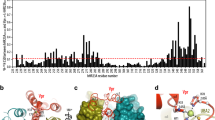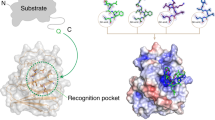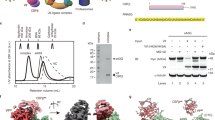Abstract
The cullin 4–DNA-damage-binding protein 1 (CUL4–DDB1) ubiquitin ligase machinery regulates diverse cellular functions and can be subverted by pathogenic viruses. Here we report the crystal structure of DDB1 in complex with a central fragment of hepatitis B virus X protein (HBx), whose DDB1-binding activity is important for viral infection. The structure reveals that HBx binds DDB1 through an α-helical motif, which is also found in the unrelated paramyxovirus SV5-V protein despite their sequence divergence. Our structure-based functional analysis suggests that, like SV5-V, HBx captures DDB1 to redirect the ubiquitin ligase activity of the CUL4–DDB1 E3 ligase. We also identify the α-helical motif shared by these viral proteins in the cellular substrate–recruiting subunits of the E3 complex, the DDB1–CUL4-associated factors (DCAFs) that are functionally mimicked by the viral hijackers. Together, our studies reveal a common yet promiscuous structural element that is important for the assembly of cellular and virally hijacked CUL4–DDB1 E3 complexes.
This is a preview of subscription content, access via your institution
Access options
Subscribe to this journal
Receive 12 print issues and online access
$189.00 per year
only $15.75 per issue
Buy this article
- Purchase on Springer Link
- Instant access to full article PDF
Prices may be subject to local taxes which are calculated during checkout






Similar content being viewed by others
References
Hershko, A. & Ciechanover, A. The ubiquitin system. Annu. Rev. Biochem. 67, 425–479 (1998).
Pickart, C.M. Mechanisms underlying ubiquitination. Annu. Rev. Biochem. 70, 503–533 (2001).
Petroski, M.D. & Deshaies, R.J. Function and regulation of cullin-RING ubiquitin ligases. Nat. Rev. Mol. Cell Biol. 6, 9–20 (2005).
Angers, S. et al. Molecular architecture and assembly of the DDB1–CUL4A ubiquitin ligase machinery. Nature 443, 590–593 (2006).
Jin, J., Arias, E.E., Chen, J., Harper, J.W. & Walter, J.C. A family of diverse Cul4-Ddb1-interacting proteins includes Cdt2, which is required for S phase destruction of the replication factor Cdt1. Mol. Cell 23, 709–721 (2006).
He, Y.J., McCall, C.M., Hu, J., Zeng, Y. & Xiong, Y. DDB1 functions as a linker to recruit receptor WD40 proteins to CUL4–ROC1 ubiquitin ligases. Genes Dev. 20, 2949–2954 (2006).
Higa, L.A. et al. CUL4–DDB1 ubiquitin ligase interacts with multiple WD40-repeat proteins and regulates histone methylation. Nat. Cell Biol. 8, 1277–1283 (2006).
Nag, A., Bondar, T., Shiv, S. & Raychaudhuri, P. The xeroderma pigmentosum group E gene product DDB2 is a specific target of cullin 4A in mammalian cells. Mol. Cell. Biol. 21, 6738–6747 (2001).
Chen, X., Zhang, Y., Douglas, L. & Zhou, P. UV-damaged DNA-binding proteins are targets of CUL-4A-mediated ubiquitination and degradation. J. Biol. Chem. 276, 48175–48182 (2001).
Sugasawa, K. et al. UV-induced ubiquitylation of XPC protein mediated by UV-DDB-ubiquitin ligase complex. Cell 121, 387–400 (2005).
Groisman, R. et al. CSA-dependent degradation of CSB by the ubiquitin-proteasome pathway establishes a link between complementation factors of the Cockayne syndrome. Genes Dev. 20, 1429–1434 (2006).
Kapetanaki, M.G. et al. The DDB1–CUL4ADDB2 ubiquitin ligase is deficient in xeroderma pigmentosum group E and targets histone H2A at UV-damaged DNA sites. Proc. Natl. Acad. Sci. USA 103, 2588–2593 (2006).
Wang, H. et al. Histone H3 and H4 ubiquitylation by the CUL4-DDB-ROC1 ubiquitin ligase facilitates cellular response to DNA damage. Mol. Cell 22, 383–394 (2006).
Liu, C. et al. Cop9/signalosome subunits and Pcu4 regulate ribonucleotide reductase by both checkpoint-dependent and -independent mechanisms. Genes Dev. 17, 1130–1140 (2003).
Higa, L.A., Mihaylov, I.S., Banks, D.P., Zheng, J. & Zhang, H. Radiation-mediated proteolysis of CDT1 by CUL4–ROC1 and CSN complexes constitutes a new checkpoint. Nat. Cell Biol. 5, 1008–1015 (2003).
Hu, J., McCall, C.M., Ohta, T. & Xiong, Y. Targeted ubiquitination of CDT1 by the DDB1–CUL4A-ROC1 ligase in response to DNA damage. Nat. Cell Biol. 6, 1003–1009 (2004).
Bondar, T., Ponomarev, A. & Raychaudhuri, P. Ddb1 is required for the proteolysis of the Schizosaccharomyces pombe replication inhibitor Spd1 during S phase and after DNA damage. J. Biol. Chem. 279, 9937–9943 (2004).
Kim, Y. & Kipreos, E.T. Cdt1 degradation to prevent DNA re-replication: conserved and non-conserved pathways. Cell Div. 2, 18 (2007).
Wertz, I.E. et al. Human De-etiolated-1 regulates c-Jun by assembling a CUL4A ubiquitin ligase. Science 303, 1371–1374 (2004).
Ghosh, P., Wu, M., Zhang, H. & Sun, H. mTORC1 signaling requires proteasomal function and the involvement of CUL4–DDB1 ubiquitin E3 ligase. Cell Cycle 7, 373–381 (2008).
Hu, J. et al. WD40 protein FBW5 promotes ubiquitination of tumor suppressor TSC2 by DDB1–CUL4-ROC1 ligase. Genes Dev. 22, 866–871 (2008).
Li, T., Chen, X., Garbutt, K.C., Zhou, P. & Zheng, N. Structure of DDB1 in complex with a paramyxovirus V protein: viral hijack of a propeller cluster in ubiquitin ligase. Cell 124, 105–117 (2006).
Wu, G. et al. Structure of a β-TrCP1-Skp1-β-catenin complex: destruction motif binding and lysine specificity of the SCF(β-TrCP1) ubiquitin ligase. Mol. Cell 11, 1445–1456 (2003).
Hao, B., Oehlmann, S., Sowa, M.E., Harper, J.W. & Pavletich, N.P. Structure of a Fbw7-Skp1-cyclin E complex: multisite-phosphorylated substrate recognition by SCF ubiquitin ligases. Mol. Cell 26, 131–143 (2007).
Barry, M. & Fruh, K. Viral modulators of cullin RING ubiquitin ligases: culling the host defense. Sci. STKE 2006, pe21 (2006).
Didcock, L., Young, D.F., Goodbourn, S. & Randall, R.E. The V protein of simian virus 5 inhibits interferon signalling by targeting STAT1 for proteasome-mediated degradation. J. Virol. 73, 9928–9933 (1999).
Parisien, J.P. et al. The V protein of human parainfluenza virus 2 antagonizes type I interferon responses by destabilizing signal transducer and activator of transcription 2. Virology 283, 230–239 (2001).
Ulane, C.M. & Horvath, C.M. Paramyxoviruses SV5 and HPIV2 assemble STAT protein ubiquitin ligase complexes from cellular components. Virology 304, 160–166 (2002).
Bouchard, M.J. & Schneider, R.J. The enigmatic X gene of hepatitis B virus. J. Virol. 78, 12725–12734 (2004).
Sitterlin, D. et al. Interaction of the UV-damaged DNA-binding protein with hepatitis B virus X protein is conserved among mammalian hepadnaviruses and restricted to transactivation-proficient X-insertion mutants. J. Virol. 71, 6194–6199 (1997).
Sitterlin, D., Bergametti, F., Tiollais, P., Tennant, B.C. & Transy, C. Correct binding of viral X protein to UVDDB-p127 cellular protein is critical for efficient infection by hepatitis B viruses. Oncogene 19, 4427–4431 (2000).
Leupin, O., Bontron, S., Schaeffer, C. & Strubin, M. Hepatitis B virus X protein stimulates viral genome replication via a DDB1-dependent pathway distinct from that leading to cell death. J. Virol. 79, 4238–4245 (2005).
Bontron, S., Lin-Marq, N. & Strubin, M. Hepatitis B virus X protein associated with UV-DDB1 induces cell death in the nucleus and is functionally antagonized by UV-DDB2. J. Biol. Chem. 277, 38847–38854 (2002).
Lin-Marq, N., Bontron, S., Leupin, O. & Strubin, M. Hepatitis B virus X protein interferes with cell viability through interaction with the p127-kDa UV-damaged DNA-binding protein. Virology 287, 266–274 (2001).
Martin-Lluesma, S. et al. Hepatitis B virus X protein affects S phase progression leading to chromosome segregation defects by binding to damaged DNA binding protein 1. Hepatology 48, 1467–1476 (2008).
Chen, H.S. et al. The woodchuck hepatitis virus X gene is important for establishment of virus infection in woodchucks. J. Virol. 67, 1218–1226 (1993).
Zoulim, F., Saputelli, J. & Seeger, C. Woodchuck hepatitis virus X protein is required for viral infection in vivo. J. Virol. 68, 2026–2030 (1994).
Bergametti, F., Bianchi, J. & Transy, C. Interaction of Hepatitis B Virus X protein with damaged DNA-binding protein p127: structural analysis and identification of antagonists. J. Biomed. Sci. 9, 706–715 (2002).
Cang, Y. et al. Deletion of DDB1 in mouse brain and lens leads to p53-dependent elimination of proliferating cells. Cell 127, 929–940 (2006).
Wakasugi, M. et al. DDB1 gene disruption causes a severe growth defect and apoptosis in chicken DT40 cells. Biochem. Biophys. Res. Commun. 364, 771–777 (2007).
Leupin, O., Bontron, S., Strubin, M., Hepatitis, B. & Virus, X. Protein and simian Vvirus 5 V protein exhibit similar UV-DDB1 binding properties to mediate distinct activities. J. Virol. 77, 6274–6283 (2003).
Andrejeva, J., Poole, E., Young, D.F., Goodbourn, S. & Randall, R.E. The p127 subunit (DDB1) of the UV-DNA damage repair binding protein is essential for the targeted degradation of STAT1 by the V protein of the paramyxovirus simian virus 5. J. Virol. 76, 11379–11386 (2002).
CCP4. The CCP4 Suite: programs for protein crystallography. Acta Crystallogr. D Biol. Crystallogr. D50, 760–763 (1994).
Jones, T.A., Zou, J.Y., Cowan, S.W. & Kjeldgaard, M. Improved methods for building protein models in electron density maps and the location of errors in these models. Acta Crystallogr. A 47, 110–119 (1991).
Brünger, A.T. et al. Crystallography & NMR system: A new software suite for macromolecular structure determination. Acta Crystallogr. D Biol. Crystallogr. 54, 905–921 (1998).
Jamai, A., Imoberdorf, R.M. & Strubin, M. Continuous histone H2B and transcription-dependent histone H3 exchange in yeast cells outside of replication. Mol. Cell 25, 345–355 (2007).
Acknowledgements
We thank Advanced Light Source synchrotron beamline staff for assistance with data collection; all members of the Zheng laboratory for invaluable discussions; W. Xu for help and support in our research; and O. Leupin (Novartis) for the siRNA-resistant DDB1 clone. N.Z. is a Pew scholar. This study is supported by the Howard Hughes Medical Institute and by a Burroughs Wellcome Fund Investigators in the Pathogenesis of Infectious Disease award and US National Institutes of Health grant CA107134 to N.Z., and Swiss National Science Foundation grants 3100A0-112496 and 31003A-127384 to M.S.
Author information
Authors and Affiliations
Contributions
T.L. designed and performed crystallographic studies, sequence analyses and GST pulldown assays. M.S., E.I.R. and P.C.v.B. designed experiments for the functional studies of the viral proteins and analyzed the data. E.I.R. and P.C.v.B. carried out the experiments. N.Z. and M.S. supervised the project and are the principal manuscript authors.
Corresponding authors
Supplementary information
Supplementary Text and Figures
Supplementary Figs. 1–9 and Supplementary Methods (PDF 920 kb)
Rights and permissions
About this article
Cite this article
Li, T., Robert, E., van Breugel, P. et al. A promiscuous α-helical motif anchors viral hijackers and substrate receptors to the CUL4–DDB1 ubiquitin ligase machinery. Nat Struct Mol Biol 17, 105–111 (2010). https://doi.org/10.1038/nsmb.1719
Received:
Accepted:
Published:
Issue Date:
DOI: https://doi.org/10.1038/nsmb.1719
This article is cited by
-
Effects of neddylation on viral infection: an overview
Archives of Virology (2024)
-
Targeting DCAF5 suppresses SMARCB1-mutant cancer by stabilizing SWI/SNF
Nature (2024)
-
Smc5/6 silences episomal transcription by a three-step function
Nature Structural & Molecular Biology (2022)
-
Blocking neddylation elicits antiviral effect against hepatitis B virus replication
Molecular Biology Reports (2022)
-
Advancing targeted protein degradation for cancer therapy
Nature Reviews Cancer (2021)



